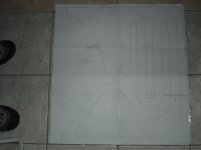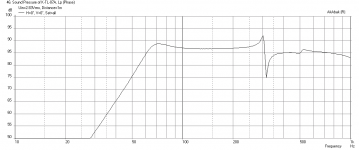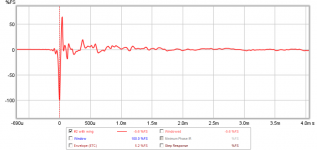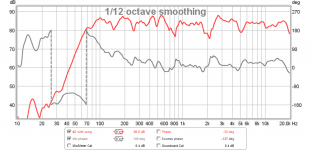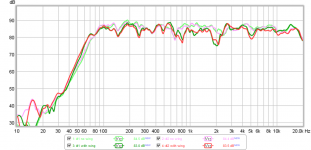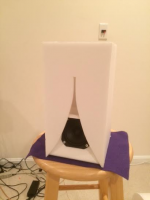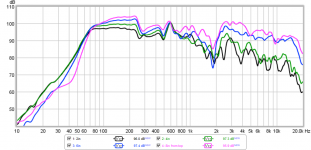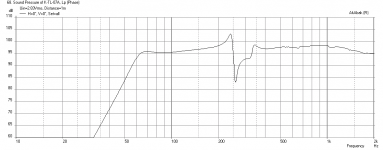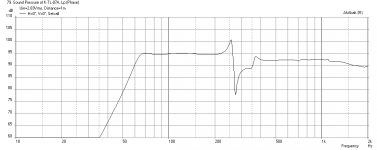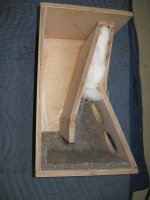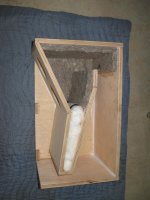What is the length of the horn defined by? What looks like a tractrix horn ends at the back with a hard wall and the bottom edge is open. I can't figure out if it's anymore than an aperiodic box. Does the half open "horn" really provide any horn loading? Have you heard one of these Freddi or have any measurements?
Last edited:
This is a BLH or TL with K aperture. It is a bit different than Karlsonator
Yes indeed xrk971.
Apart from the K-slit, it is a totally a different enclosure (*) compared to a Karlsonator.
I posted on this only because the impedance measurement show the isolated effect of the K-aperture, giving a weak answer to sabaspeed’s question.
Acoustic wise, that K-slit provided very good effect (better dispersion? Minimum standing waves? Both?) at mid and high frequences
George
(*)As the folded channel has a constant cross section with an area equal to driver’s effective area, it is not a BLH. The length of the channel is a qw of the driver’s Fr on air. Together with the rear volume immediately behind the driver, they were calculated to operate as a well damped BR.
The surprise on the outcome was that the cone displacement -even at high volume settings- was minimal and totally controlled at any frequency, even below the calculated resonance frequency. So I guess, it doesn’t qualify as a BR either 😀
In fact, visually, the cone didn’t move at all, despite the ample LF acoustic output from the speaker. I had to touch the cone with my finger to sense it vibrating.
George
Attachments
Last edited:
Sounds like horn loading to me. 🙂
On my tractrix synergy I had to touch the cone and even then could hardly tell it was vibrating even though output was 100+dB. The sims showed 35microns displacement.
On my tractrix synergy I had to touch the cone and even then could hardly tell it was vibrating even though output was 100+dB. The sims showed 35microns displacement.
hi X - here's a 2002 note I posted: "-for comparison in AES preprint 1255 (1977), Bob Reams used a JBL 4560 loaded with 1-2220 and compared this enclosure outdoors to his 3'x3'x2' Karlson-Hypex loaded with 2-D140 - the figures adjusted for one watt/4 feet at 200Hz were 106.76dB for 2220/4560 combo and 108.56dB for the Karlson-Hypex. The 1/3 octave RTA show a 3dB window from 80 to past 500hz on axis , to nearly 500 30 degrees off axis, and ~315Hz 45 degrees off axis. Reams stated 40hz to be ~9dB down - that's impressive performance (wish he were available for comments - I suspect Bob had more understanding of Karlson techniques than anyone after Mr. Karlson's passing) "
the JBL 4560 was a reflex/midbass horn hybrid like Altec's VOT http://www.jblpro.com/pub/obsolete/Low_Frequency_Enclosures2.pdf
don't know if I have a copy of the AES paper anymore - its interesting that the Hypex worked - IIRC it had ~3 cubic foot rear chamber per 15"
I like K's - best for dynamics with minimal cone movement in a reasonable package
the JBL 4560 was a reflex/midbass horn hybrid like Altec's VOT http://www.jblpro.com/pub/obsolete/Low_Frequency_Enclosures2.pdf
don't know if I have a copy of the AES paper anymore - its interesting that the Hypex worked - IIRC it had ~3 cubic foot rear chamber per 15"
I like K's - best for dynamics with minimal cone movement in a reasonable package
Last edited:
Dayton RS100-4 looks like a good driver for 0.4x
The Dayton RS100-4 appears to be a very nice driver with the good combination of correct Qts, large xmax of 4mm, and a very smooth response according to the factory specs. Dayton Audio RS100-4 4" Reference Full-Range Driver 4 Ohm
It also sim's very well in a 0.4x mini Karlsonator with nice flat bass extension to about 60Hz and decent sensitivity.
Someone should give it a try, and at $28 - looks like a nice deal for how well built it is (allow frame, anodized aluminum cone, aluminum phase plug, vented spider, etc.).
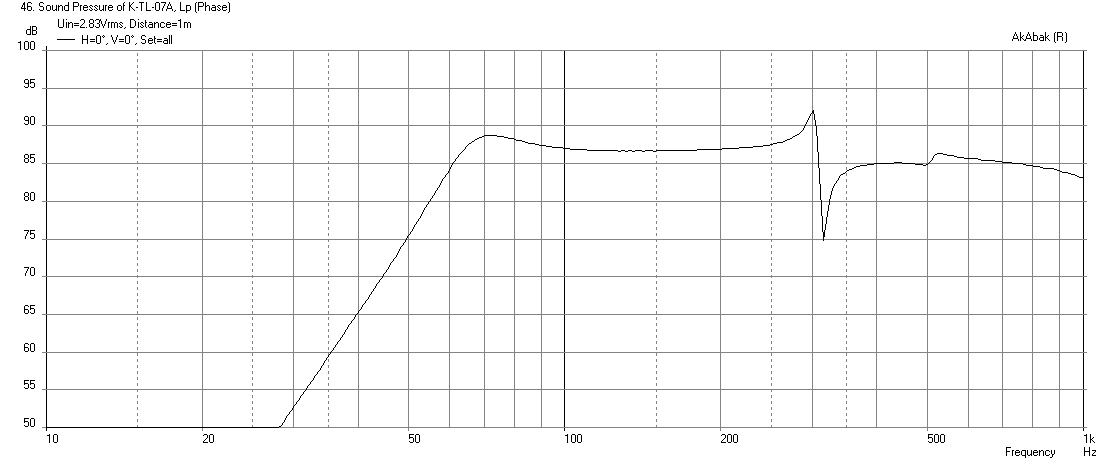
The Dayton RS100-4 appears to be a very nice driver with the good combination of correct Qts, large xmax of 4mm, and a very smooth response according to the factory specs. Dayton Audio RS100-4 4" Reference Full-Range Driver 4 Ohm
It also sim's very well in a 0.4x mini Karlsonator with nice flat bass extension to about 60Hz and decent sensitivity.
Someone should give it a try, and at $28 - looks like a nice deal for how well built it is (allow frame, anodized aluminum cone, aluminum phase plug, vented spider, etc.).

Attachments
hi X - here's a 2002 note I posted: "-for comparison in AES preprint 1255 (1977)...
the JBL 4560 was a reflex/midbass horn hybrid like Altec's VOT http://www.jblpro.com/pub/obsolete/Low_Frequency_Enclosures2.pdf
Thanks for the links Freddi.
X
0.4x Build using Score & Fold Technique
I am detailing how to build the 0.4x using the score and fold method where the front, top, bottom, back, and insides are all made using a long strip that is scored with a blunt tip and folded. It goes really fast as you only have to cut a long uniform width strip (6.0 in this case). The top and back require a second strip as it is not long enough. The speaker takes about 2 hrs to make from cutting gluing. It was made completely using hot melt glue so the gluing goes pretty fast.
Pieces ready and scored:
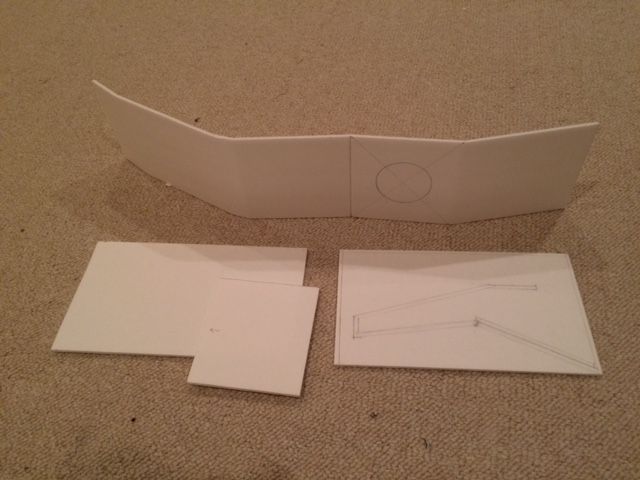
Start gluing bottom first, then front:
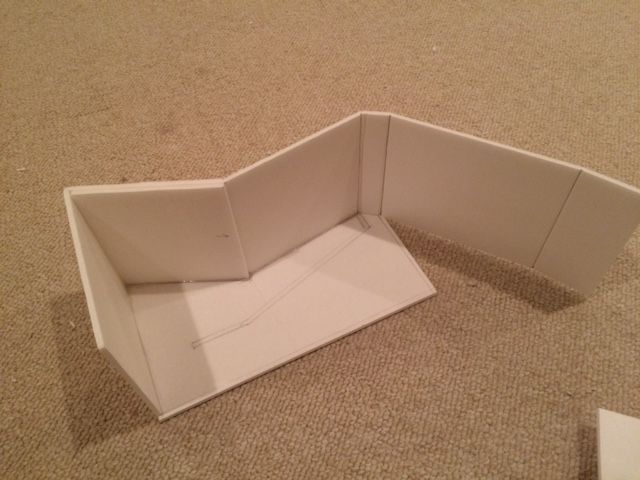
Glue on back:
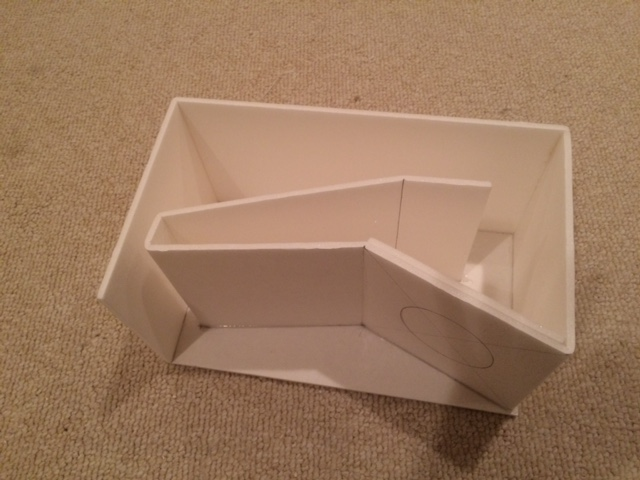
Add braces and damping material (foam behind driver and stuffing above driver):
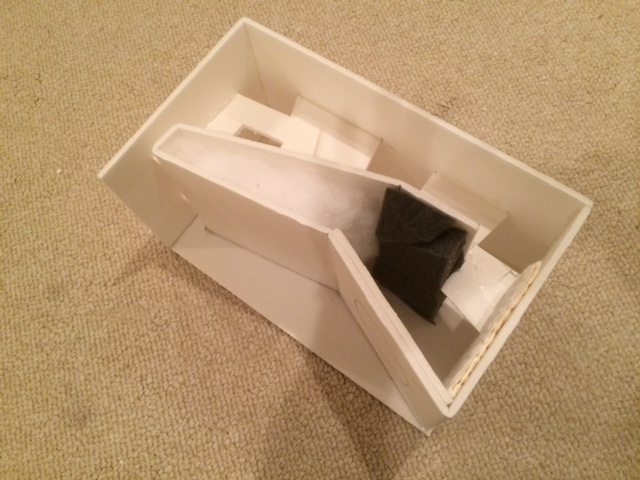
Completed speaker without driver (Cat 5 single strands used for wiring):
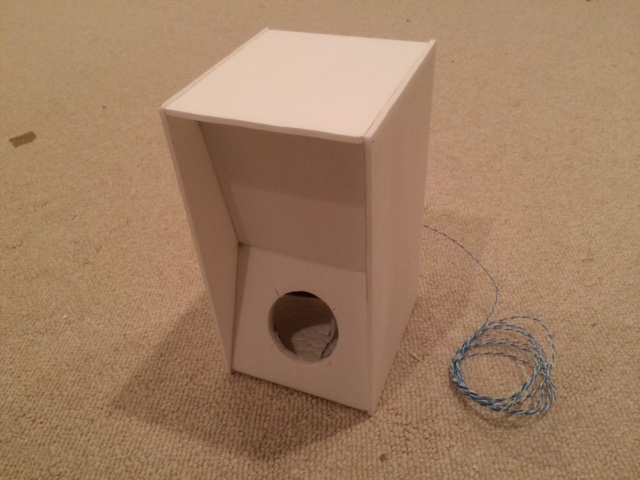
Installed TC9FD and ready for measurement (without K-aperture):
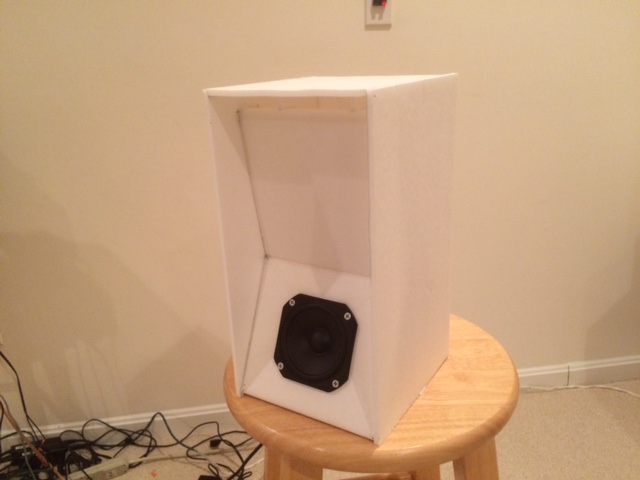
Measurement of freq response and HD without wing at 0.5m:
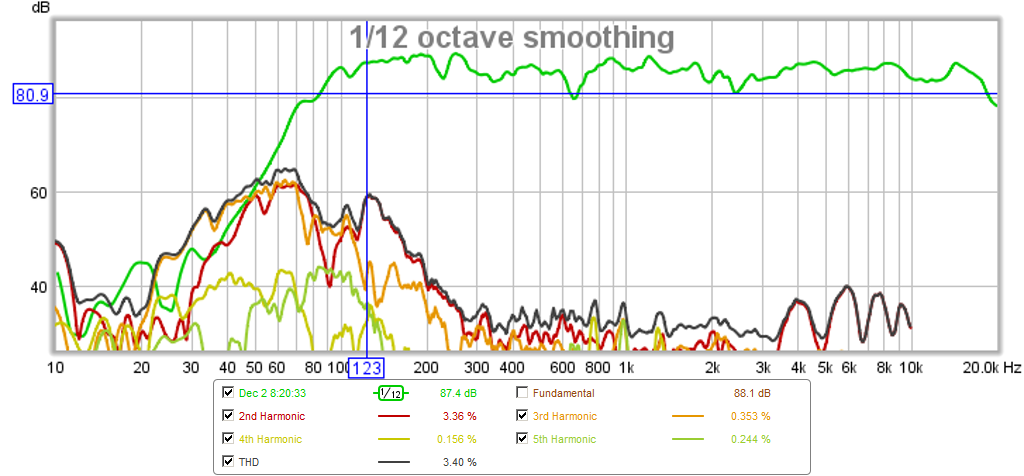
I can hear some cabinet vibrations which gives the higher than normal HD below 300Hz. Could use some CLD...
I am detailing how to build the 0.4x using the score and fold method where the front, top, bottom, back, and insides are all made using a long strip that is scored with a blunt tip and folded. It goes really fast as you only have to cut a long uniform width strip (6.0 in this case). The top and back require a second strip as it is not long enough. The speaker takes about 2 hrs to make from cutting gluing. It was made completely using hot melt glue so the gluing goes pretty fast.
Pieces ready and scored:

Start gluing bottom first, then front:

Glue on back:

Add braces and damping material (foam behind driver and stuffing above driver):

Completed speaker without driver (Cat 5 single strands used for wiring):

Installed TC9FD and ready for measurement (without K-aperture):

Measurement of freq response and HD without wing at 0.5m:

I can hear some cabinet vibrations which gives the higher than normal HD below 300Hz. Could use some CLD...
Attachments
-
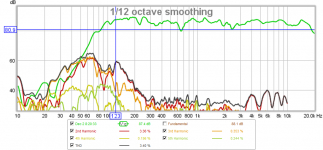 0.4x-Knator-No-Wing-Freq-0.5m.png152 KB · Views: 2,213
0.4x-Knator-No-Wing-Freq-0.5m.png152 KB · Views: 2,213 -
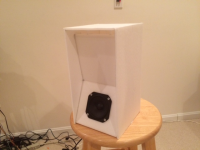 0.4x-Knator-Build-fold-05.png273.9 KB · Views: 2,289
0.4x-Knator-Build-fold-05.png273.9 KB · Views: 2,289 -
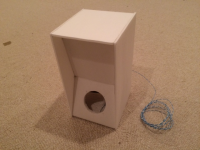 0.4x-Knator-Build-fold-04b.png357.9 KB · Views: 2,217
0.4x-Knator-Build-fold-04b.png357.9 KB · Views: 2,217 -
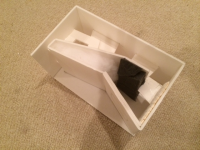 0.4x-Knator-Build-fold-04.png400.7 KB · Views: 2,234
0.4x-Knator-Build-fold-04.png400.7 KB · Views: 2,234 -
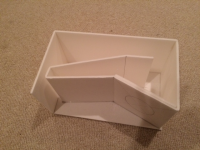 0.4x-Knator-Build-fold-03.png364.4 KB · Views: 2,235
0.4x-Knator-Build-fold-03.png364.4 KB · Views: 2,235 -
 0.4x-Knator-Build-fold-02.png386.2 KB · Views: 2,375
0.4x-Knator-Build-fold-02.png386.2 KB · Views: 2,375 -
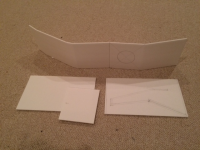 0.4x-Knator-Build-fold-01.png420.8 KB · Views: 2,361
0.4x-Knator-Build-fold-01.png420.8 KB · Views: 2,361
Last edited:
The Dayton RS100-4 appears to be a very nice driver with the good combination of correct Qts, large xmax of 4mm, and a very smooth response according to the factory specs. Dayton Audio RS100-4 4" Reference Full-Range Driver 4 Ohm
It also sim's very well in a 0.4x mini Karlsonator with nice flat bass extension to about 60Hz and decent sensitivity.
Someone should give it a try, and at $28 - looks like a nice deal for how well built it is (allow frame, anodized aluminum cone, aluminum phase plug, vented spider, etc.).

Could be worth a try. FWIW I have noticed that both Karlsons and my little Karlsonators tend to slightly exaggerate the metallic sibilance of metal coned full rangers - just a little bit. Obviously, this signature varies from driver to driver, and it ca, the older CHR70 in mini K'ators sounds pretty darn good, but I can just discern a little eensy bit of coloration, which for whatever reason comes across as something more like 'airiness' in direct radiating BR.
Seems like the Fostex FF105WK might sound nice. One of these days I will have to try my FE108EZ for the hell of it.
0.4x Build using Score & Fold Technique Finished
Added wings and made measurements with and without. There are a couple of dips that the K-aperture wings introduce, but it does extend the bass somewhat. Note that the design has a fairly flat response with respect to baffle step losses. No BSC is needed for a balanced sound. The price of the dips is in my opinion, worth it for the improved dispersion and deeper bass extension. It sounds very nice and you don't notice the dips upon listening.
Completed speaker with wings:
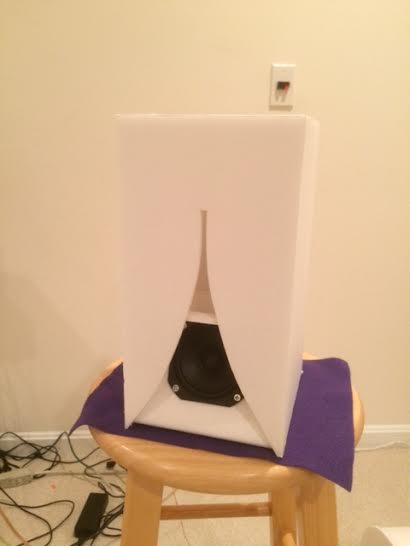
Measurement of unit #1 and #2 with and without wings:
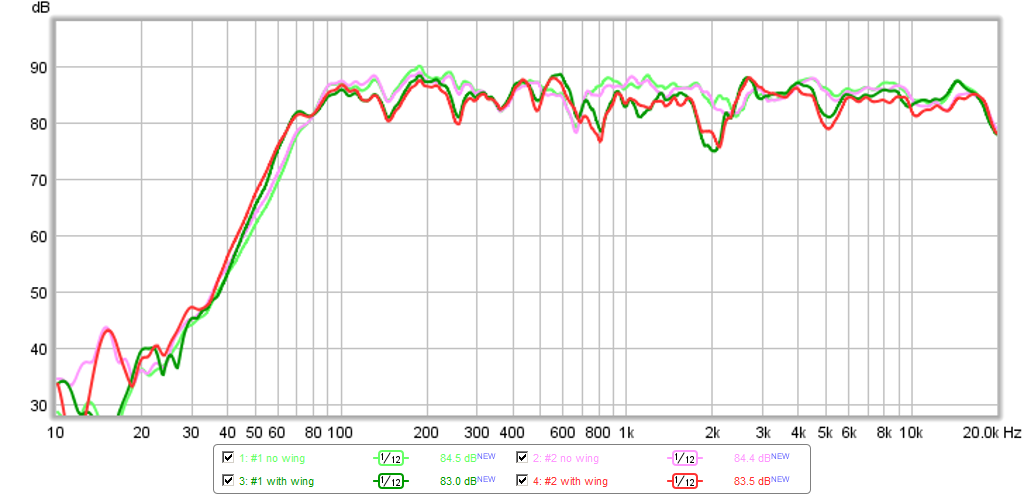
Minimum phase without wings:
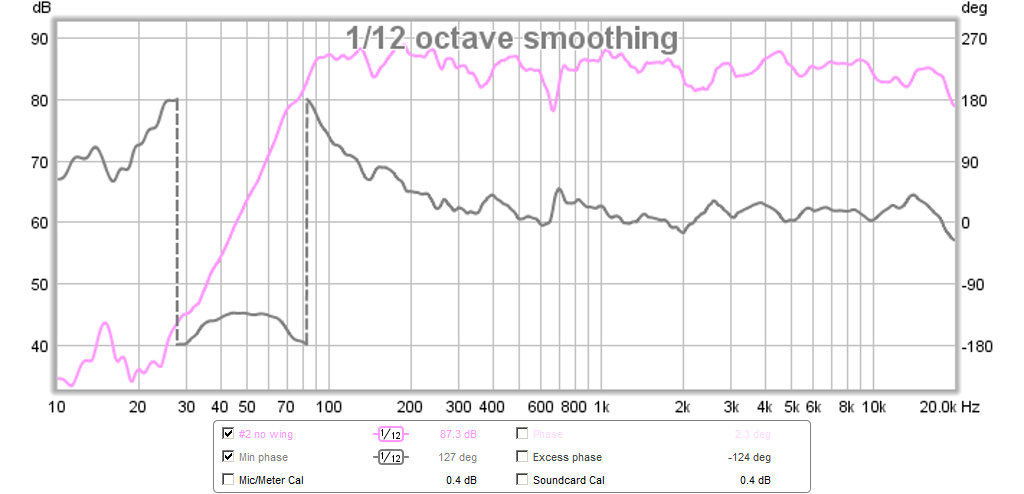
Minimum phase with wings:
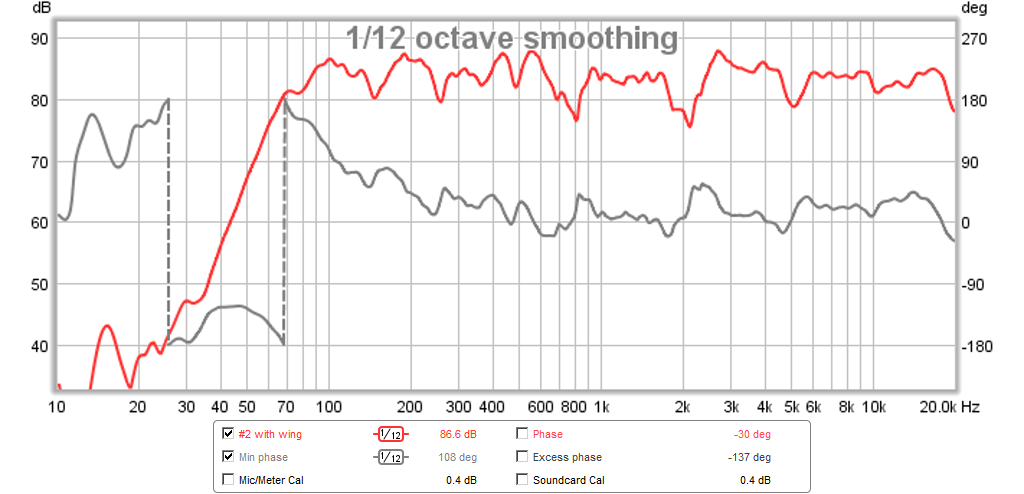
Impulse response with wings:
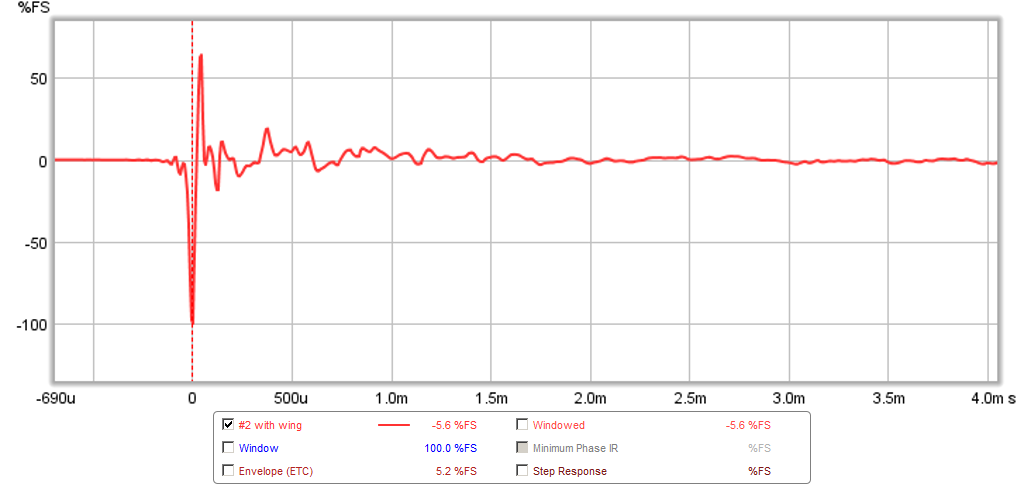
Added wings and made measurements with and without. There are a couple of dips that the K-aperture wings introduce, but it does extend the bass somewhat. Note that the design has a fairly flat response with respect to baffle step losses. No BSC is needed for a balanced sound. The price of the dips is in my opinion, worth it for the improved dispersion and deeper bass extension. It sounds very nice and you don't notice the dips upon listening.
Completed speaker with wings:

Measurement of unit #1 and #2 with and without wings:

Minimum phase without wings:

Minimum phase with wings:

Impulse response with wings:

Attachments
Last edited:
Never seen before: Measurement along slot axis
I wanted to see what the variation of output was as a function of the position along the Karlson aperture axis. I made nearfield measurements 1 in away from the plane of the aperture or K-wing at 2in, 4in, 6in, and 8in below the top edge of the slot. It is not surprising that the output frequency content is different at different positions. The classic Karlson "W" is very apparent and matches the sims with the first notch at 250hz to 500Hz. It is interesting how in the far-field, all this integrates out and you get something much smoother as presented in the posts above. The knee of the bass shelf is very clearly 75Hz in this measurement and that agrees with the sims also.
I don't think I have ever seen this type of measurement anywhere - maybe Freddi has?
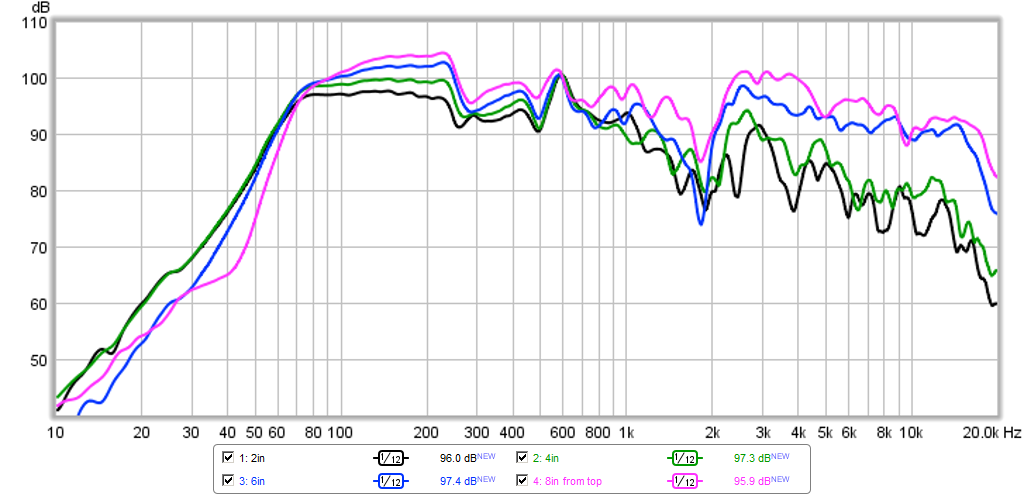
I wanted to see what the variation of output was as a function of the position along the Karlson aperture axis. I made nearfield measurements 1 in away from the plane of the aperture or K-wing at 2in, 4in, 6in, and 8in below the top edge of the slot. It is not surprising that the output frequency content is different at different positions. The classic Karlson "W" is very apparent and matches the sims with the first notch at 250hz to 500Hz. It is interesting how in the far-field, all this integrates out and you get something much smoother as presented in the posts above. The knee of the bass shelf is very clearly 75Hz in this measurement and that agrees with the sims also.
I don't think I have ever seen this type of measurement anywhere - maybe Freddi has?

Attachments
Last edited:
here's one of the 1960's X15 K-tube with an old Peavey 22A compression driver almost 90 degrees off axis. That K-tube was 1.875" in diameter with a parabolic slot and was not as smooth as the 1"ID type - you can see the mic in the picture
open end waveguide patent http://www.google.com/patents/US3445852
An externally hosted image should be here but it was not working when we last tested it.
open end waveguide patent http://www.google.com/patents/US3445852
An externally hosted image should be here but it was not working when we last tested it.
Last edited:
I've read the entire thread! Pondering how it works, it is winter and I need a new project. From what I understand (please correct me if I'm wrong) if I use two Faital Pro 4FE35 full ranges (the ceramic magnet version because the Qts is better?) it should work well in a 0.53 Karlsonator and be flattish to 60Hz? The 4FE32 should not be used because the 0.5 Qts is too low and the 4FE35 ceramic magnet version has a Qts of 1.16?
My plan is to use some Aurasound 3" full ranges (Qts of 1.4 Fs 135Hz) to build a pair of 0.53 then play around with stuffing etc. then move to the Faital Pro 4 inchers to get some decent bass and higher output/power handling for a 40 watt chip amp into the 4 ohm load. If I notice the 3 inchers can produce some form of bass--then I'll upgrade to the Faital Pros for the final build. I plan on using 3/8ths for the box and 1/2" ply for the bezel, transmission line path and the Karlson slot. Braces all around.
Will my Aurasound 16 ohm really high Qts of 1.4 be a really bad match for the 0.53? Did my brain go numb from reading and the Neo Faital Pro 4" be decent or does it need a completely different cabinet...or is the Neo a lost cause? I like the Neo since the chart seems to indicate better efficiency and it will make the cabinets lighter.
Unless I really like the Karlsonator and want to make a 4 driver per cabinet version--would that be OK or will it create havoc with four? Would four of them be a vertical line array style or would it be a "diamond"?
First I'll use those Aurasounds then figure out what Faital Pros will work best in a 0.53 cabinet. Great design with the transmission line and Karlson aperture... Hope I can get close!
My plan is to use some Aurasound 3" full ranges (Qts of 1.4 Fs 135Hz) to build a pair of 0.53 then play around with stuffing etc. then move to the Faital Pro 4 inchers to get some decent bass and higher output/power handling for a 40 watt chip amp into the 4 ohm load. If I notice the 3 inchers can produce some form of bass--then I'll upgrade to the Faital Pros for the final build. I plan on using 3/8ths for the box and 1/2" ply for the bezel, transmission line path and the Karlson slot. Braces all around.
Will my Aurasound 16 ohm really high Qts of 1.4 be a really bad match for the 0.53? Did my brain go numb from reading and the Neo Faital Pro 4" be decent or does it need a completely different cabinet...or is the Neo a lost cause? I like the Neo since the chart seems to indicate better efficiency and it will make the cabinets lighter.
Unless I really like the Karlsonator and want to make a 4 driver per cabinet version--would that be OK or will it create havoc with four? Would four of them be a vertical line array style or would it be a "diamond"?
First I'll use those Aurasounds then figure out what Faital Pros will work best in a 0.53 cabinet. Great design with the transmission line and Karlson aperture... Hope I can get close!
If you really want to use the Nd 4FE32's the design can work well. Let me run some simulations to see what the optimum scaling is. Two 8ohm 4FE32's in parallel will give you 97dB sensitivity at 2.83v.
If you really want to use the Nd 4FE32's the design can work well. Let me run some simulations to see what the optimum scaling is. Two 8ohm 4FE32's in parallel will give you 97dB sensitivity at 2.83v.
Thank You!
I find the design very interesting--the line arrays and PPSL subs are complete so I'm looking for a pair of speakers I can actually pick up and move. Using rough math, the 94dB of the Neo 4" Faital Pros coupled with 40 watts into 4 ohms from a chip amp should give me 110dB at one meter--more or less.
I don't think I'll need any more for near field speakers and general music needs with that level of output. 😎
Thanks again for your help and a great design.
You get a 6dB boost for running two 8ohm drivers in parallel as 4ohm loads. 3dB from two drivers and 3dB from going from 8ohms to 4ohms which is double the current for same 2.83v drive. 91dB + 6dB = 97dB. It is really double the power input though (2watts). 40 watts is about 20dB more so I get 117dB. But you have to look at cone xmax which is usually the limiting factor when not running it with a high pass filter.
Dual 4FE32's and 4FE35's in mini-K'nator
The 4FE32 (8ohm wired parallel for 4ohm) is best in a 0.62x scale Karlsonator, it will get low 60Hz (-3dB) bass extension and have some amazing sensitivity - a 2 to 5 watt amp should work:
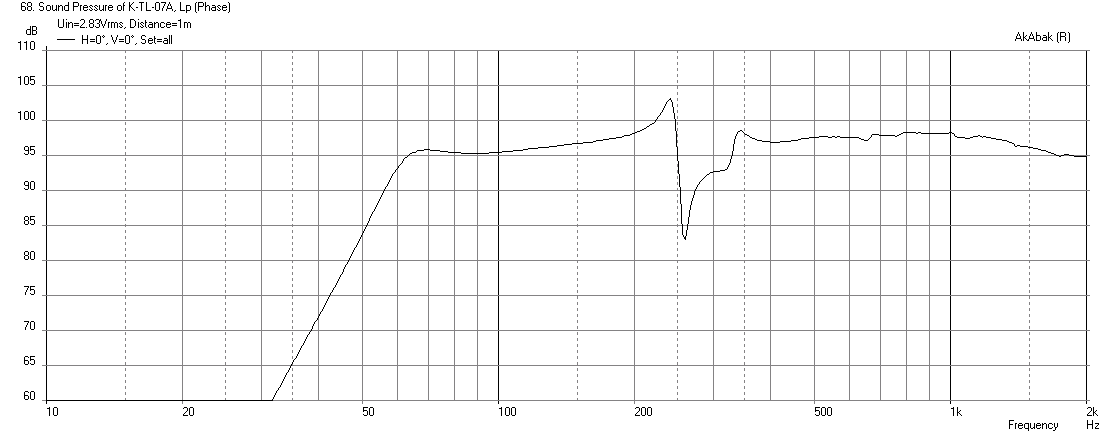
The 4FE35 (8ohm wired parallel for 4ohm) is best in a 0.57x scale Karlsonator, it will have more bass relative to mids than the 4FE32 and about the same bass extension into the low 60Hz (-3dB):
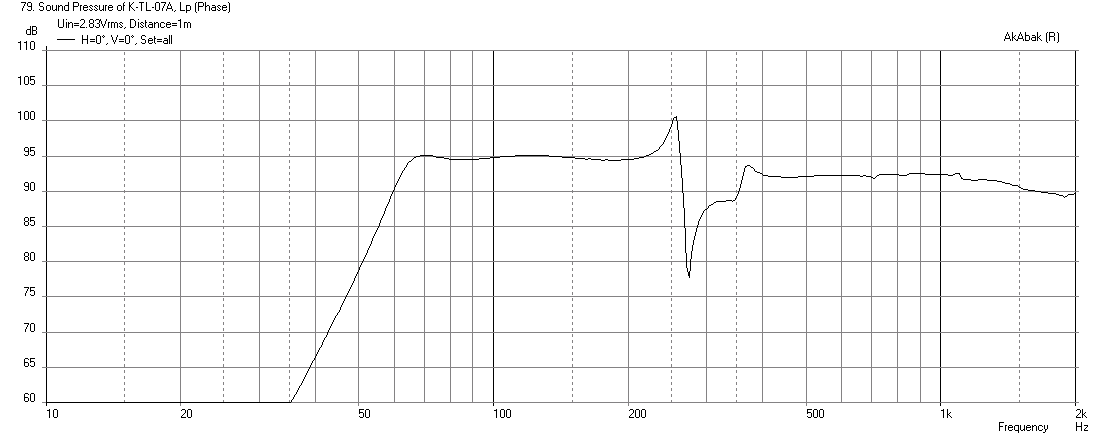
If your music has a lot of low frequency content, you may want to do a passive line-level -12dB/oct high pass filter at circa 40Hz between the source and the amp. More info on how to make those here (very inexpensive as it is 2 resistors and 2 small caps, but you need a high input impedance amp and a fairly good line level pre-amp): TLS.org | Passive Line-Level Crossover If you run full range without the high pass be careful not to put more than 8 or 10 watts into them.
I've read the entire thread! Pondering how it works, it is winter and I need a new project. From what I understand (please correct me if I'm wrong) if I use two Faital Pro 4FE35 full ranges (the ceramic magnet version because the Qts is better?) it should work well in a 0.53 Karlsonator and be flattish to 60Hz? The 4FE32 should not be used because the 0.5 Qts is too low and the 4FE35 ceramic magnet version has a Qts of 1.16?
My plan is to use some Aurasound 3" full ranges (Qts of 1.4 Fs 135Hz) to build a pair of 0.53 then play around with stuffing etc. then move to the Faital Pro 4 inchers to get some decent bass and higher output/power handling for a 40 watt chip amp into the 4 ohm load. If I notice the 3 inchers can produce some form of bass--then I'll upgrade to the Faital Pros for the final build. I plan on using 3/8ths for the box and 1/2" ply for the bezel, transmission line path and the Karlson slot. Braces all around.
Will my Aurasound 16 ohm really high Qts of 1.4 be a really bad match for the 0.53? Did my brain go numb from reading and the Neo Faital Pro 4" be decent or does it need a completely different cabinet...or is the Neo a lost cause? I like the Neo since the chart seems to indicate better efficiency and it will make the cabinets lighter.
Unless I really like the Karlsonator and want to make a 4 driver per cabinet version--would that be OK or will it create havoc with four? Would four of them be a vertical line array style or would it be a "diamond"?
First I'll use those Aurasounds then figure out what Faital Pros will work best in a 0.53 cabinet. Great design with the transmission line and Karlson aperture... Hope I can get close!
The 4FE32 (8ohm wired parallel for 4ohm) is best in a 0.62x scale Karlsonator, it will get low 60Hz (-3dB) bass extension and have some amazing sensitivity - a 2 to 5 watt amp should work:

The 4FE35 (8ohm wired parallel for 4ohm) is best in a 0.57x scale Karlsonator, it will have more bass relative to mids than the 4FE32 and about the same bass extension into the low 60Hz (-3dB):

If your music has a lot of low frequency content, you may want to do a passive line-level -12dB/oct high pass filter at circa 40Hz between the source and the amp. More info on how to make those here (very inexpensive as it is 2 resistors and 2 small caps, but you need a high input impedance amp and a fairly good line level pre-amp): TLS.org | Passive Line-Level Crossover If you run full range without the high pass be careful not to put more than 8 or 10 watts into them.
Attachments
Last edited:
Mini K with dual TC9FD's
I have a question on my dampening set up, but first would like to thank everyone for their enthusiasm and time . X for sure, Greg B great drawings, it got me fired up
 .???? Is there anything I should change? Materials , two layers of carpet felt padding and acoustistuff in 1/2 ply enclosure.
.???? Is there anything I should change? Materials , two layers of carpet felt padding and acoustistuff in 1/2 ply enclosure.
I have a question on my dampening set up, but first would like to thank everyone for their enthusiasm and time . X for sure, Greg B great drawings, it got me fired up
Attachments
I have a question on my dampening set up, but first would like to thank everyone for their enthusiasm and time . X for sure, Greg B great drawings, it got me fired up.???? Is there anything I should change? Materials , two layers of carpet felt padding and acoustistuff in 1/2 ply enclosure.
Looks great! I wouldn't change anything. 🙂
Hey guys so thought I'd just throw a bone out there, making another set of minikarlsons for my mom for christmas, but this one will be ocean blue, I hope I do a decent enough finish to make them look pro 🙂.
Oh and good job Frazier I like those supports for the wings, I may consider putting some in. Do any of you guys paint inside of the wings (sides, beyond the baffle) I'm considering it but not looking forward to lots of masking.
Oh and good job Frazier I like those supports for the wings, I may consider putting some in. Do any of you guys paint inside of the wings (sides, beyond the baffle) I'm considering it but not looking forward to lots of masking.
- Home
- Loudspeakers
- Full Range
- Mini Karlsonator (0.53X) with Dual TC9FDs
